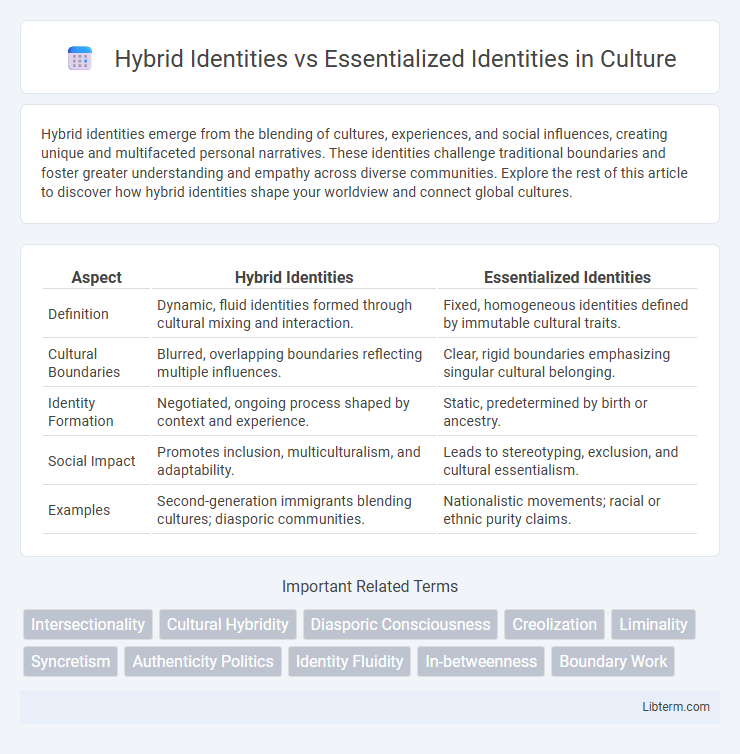Hybrid identities emerge from the blending of cultures, experiences, and social influences, creating unique and multifaceted personal narratives. These identities challenge traditional boundaries and foster greater understanding and empathy across diverse communities. Explore the rest of this article to discover how hybrid identities shape your worldview and connect global cultures.
Table of Comparison
| Aspect | Hybrid Identities | Essentialized Identities |
|---|---|---|
| Definition | Dynamic, fluid identities formed through cultural mixing and interaction. | Fixed, homogeneous identities defined by immutable cultural traits. |
| Cultural Boundaries | Blurred, overlapping boundaries reflecting multiple influences. | Clear, rigid boundaries emphasizing singular cultural belonging. |
| Identity Formation | Negotiated, ongoing process shaped by context and experience. | Static, predetermined by birth or ancestry. |
| Social Impact | Promotes inclusion, multiculturalism, and adaptability. | Leads to stereotyping, exclusion, and cultural essentialism. |
| Examples | Second-generation immigrants blending cultures; diasporic communities. | Nationalistic movements; racial or ethnic purity claims. |
Defining Hybrid Identities
Hybrid identities emerge from the intersection of multiple cultural, ethnic, or social backgrounds, reflecting fluidity and adaptability rather than fixed traits. Unlike essentialized identities, which assume singular, unchanging characteristics tied to one group, hybrid identities embrace multiplicity, negotiating various influences and experiences. This dynamic nature enables individuals to navigate and blend diverse cultural frameworks, creating unique self-expressions and social interactions.
Understanding Essentialized Identities
Essentialized identities refer to fixed, simplistic classifications that reduce individuals or groups to a single defining characteristic, ignoring the complexity and fluidity of personal and social experiences. This rigid framework often perpetuates stereotypes and limits the recognition of intersecting identities shaped by culture, history, and context. Understanding essentialized identities requires analyzing how these reductive labels impact social dynamics, power structures, and individual self-perception within diverse societies.
Historical Roots of Identity Constructs
Hybrid identities emerge from the dynamic interplay of cultures, reflecting historical processes like colonization, migration, and globalization that blend diverse traditions into multifaceted self-conceptions. Essentialized identities, by contrast, originate from fixed, often politically motivated classifications that seek to define groups through rigid, homogenous characteristics established during colonial and nationalist projects. These historical roots shape contemporary identity constructs by influencing social boundaries, power dynamics, and individual affiliations within multicultural societies.
The Role of Culture in Shaping Identity
Hybrid identities emerge from the dynamic interplay of multiple cultural influences, reflecting fluid and evolving self-conceptions that resist fixed categorizations. In contrast, essentialized identities rely on perceived innate, unchanging cultural traits, often simplifying complex individual experiences into monolithic groups. Culture shapes identity by providing symbols, practices, and narratives that individuals internalize, negotiate, or challenge, leading to either hybrid expressions or essentialist frameworks within social contexts.
Fluidity vs Fixity: Core Differences
Hybrid identities emphasize fluidity by allowing individuals to blend multiple cultural, social, and personal influences, challenging fixed or essentialist notions of identity. Essentialized identities rely on fixity, defining individuals by static, often narrowly constructed traits tied to race, ethnicity, or nationality. The core difference lies in hybrid identities embracing change and multiplicity, while essentialized identities maintain rigid boundaries and singular definitions.
Impacts on Social Belonging and Exclusion
Hybrid identities foster a dynamic sense of social belonging by enabling individuals to navigate multiple cultural frameworks, reducing rigid boundaries and mitigating exclusionary practices. Essentialized identities, by contrast, impose fixed and often stereotypical group definitions, which can reinforce social exclusion and marginalization. The fluidity inherent in hybrid identities promotes inclusivity and cross-cultural understanding, whereas essentialized identities tend to maintain social divisions and limit interpersonal acceptance.
Hybrid Identities in Globalized Societies
Hybrid identities in globalized societies reflect the fluid and dynamic nature of cultural belonging, integrating elements from multiple ethnic, national, and social backgrounds. These identities challenge essentialized identities by emphasizing multiplicity, adaptability, and the negotiation of diverse cultural influences in everyday life. The proliferation of digital media, transnational migration, and intercultural exchanges further facilitate the formation of hybrid identities that resist fixed categorization and promote inclusivity.
Media Representations and Identity Narratives
Media representations of hybrid identities challenge monolithic cultural portrayals by highlighting fluidity and intersectionality in identity narratives. Essentialized identities often reinforce fixed stereotypes, limiting audience understanding to reductive categories, while hybrid identity portrayals foster nuanced dialogues around multiplicity and transformation. These diverse narratives contribute to broader cultural recognition and resistance against singular, static identity constructs in contemporary media landscapes.
Challenges of Navigating Multiple Identities
Navigating multiple identities in hybrid identities presents challenges such as identity conflict, social exclusion, and cultural dissonance, often causing psychological stress and confusion. Essentialized identities impose rigid categories that disregard individual complexity and fluidity, limiting personal expression and social acceptance. Balancing these identities requires constant negotiation across differing social contexts, impacting mental health and community belonging.
Moving Towards Inclusive Identity Recognition
Hybrid identities reflect the fluid, multifaceted nature of individual and collective experiences, integrating diverse cultural, social, and historical influences that challenge rigid essentialized identities. Moving towards inclusive identity recognition requires embracing hybridity as a dynamic process that validates intersectionality and resists reductive categorizations. This approach promotes social cohesion and equity by acknowledging the complexity and multiplicity inherent in personal and group identities.
Hybrid Identities Infographic

 libterm.com
libterm.com